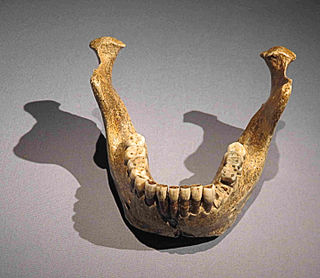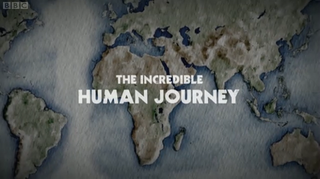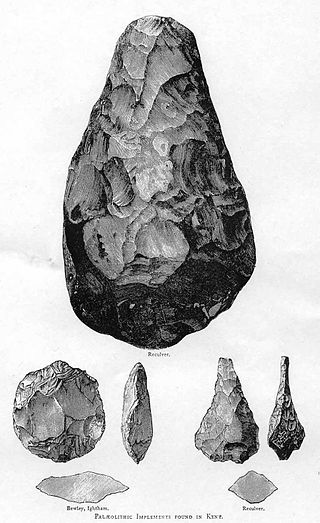Related Research Articles

The Paleolithic or Palaeolithic, also called the Old Stone Age, is a period in human prehistory that is distinguished by the original development of stone tools, and which represents almost the entire period of human prehistoric technology. It extends from the earliest known use of stone tools by hominins, c. 3.3 million years ago, to the end of the Pleistocene, c. 11,650 cal BP.

Early modern human (EMH), or anatomically modern human (AMH), are terms used to distinguish Homo sapiens that are anatomically consistent with the range of phenotypes seen in contemporary humans, from extinct archaic human species. This distinction is useful especially for times and regions where anatomically modern and archaic humans co-existed, for example, in Paleolithic Europe. Among the oldest known remains of Homo sapiens are those found at the Omo-Kibish I archaeological site in south-western Ethiopia, dating to about 233,000 to 196,000 years ago, the Florisbad site in South Africa, dating to about 259,000 years ago, and the Jebel Irhoud site in Morocco, dated about 315,000 years ago.

Homo heidelbergensis is an extinct species or subspecies of archaic human which existed from around 600,000 to 300,000 years ago, during the Middle Pleistocene. Homo heidelbergensis was widely considered the most recent common ancestor of modern humans and Neanderthals, but this view has been increasingly disputed since the late 2010s.

Homo is a genus of great ape that emerged from the genus Australopithecus and encompasses only a single extant species, Homo sapiens, along with a number of extinct species classified as either ancestral or closely related to modern humans; these include Homo erectus and Homo neanderthalensis. The oldest member of the genus is Homo habilis, with records of just over 2 million years ago. Homo, together with the genus Paranthropus, is probably most closely related to the species Australopithecus africanus within Australopithecus. The closest living relatives of Homo are of the genus Pan, with the ancestors of Pan and Homo estimated to have diverged around 5.7-11 million years ago during the Late Miocene.

The Steinheim skull is a fossilized skull of a Homo neanderthalensis or Homo heidelbergensis found on 24 July 1933 near Steinheim an der Murr, Germany.
Human taxonomy is the classification of the human species within zoological taxonomy. The systematic genus, Homo, is designed to include both anatomically modern humans and extinct varieties of archaic humans. Current humans have been designated as subspecies Homo sapiens sapiens, differentiated, according to some, from the direct ancestor, Homo sapiens idaltu.

Archaic humans is a broad category denoting all species of the genus Homo that are not Homo sapiens, which are sometimes also called Homo sapiens sapiens, in which case the singular use of sapiens has been applied to some archaic humans as well. Among the earliest modern human remains are those from Jebel Irhoud in Morocco, Florisbad in South Africa (259 ka), Omo-Kibish I in southern Ethiopia, and Apidima Cave in Southern Greece. Some examples of archaic humans include H. antecessor (1200–770 ka), H. bodoensis (1200–300 ka), H. heidelbergensis (600–200 ka), Neanderthals, H. rhodesiensis (300–125 ka) and Denisovans.
Homo sapiens is the taxonomic binomial species name for modern humans.
Paleolithic Europe, or Old Stone Age Europe, encompasses the Paleolithic or Old Stone Age in Europe from the arrival of the first archaic humans, about 1.4 million years ago until the beginning of the Mesolithic around 10,000 years ago. This period thus covers over 99% of the total human presence on the European continent. The early arrival and disappearance of Homo erectus and Homo heidelbergensis, the appearance, complete evolution and eventual demise of Homo neanderthalensis and the immigration and successful settlement of Homo sapiens all have taken place during the European Paleolithic.

The Hominidae, whose members are known as the great apes or hominids, are a taxonomic family of primates that includes eight extant species in four genera: Pongo ; Gorilla ; Pan ; and Homo, of which only modern humans remain.

The Incredible Human Journey is a five-episode, 300-minute, science documentary film presented by Alice Roberts, based on her book by the same name. The film was first broadcast on BBC television in May and June 2009 in the UK. It explains the evidence for the theory of early human migrations out of Africa and subsequently around the world, supporting the Out of Africa Theory. This theory claims that all modern humans are descended from anatomically modern African Homo sapiens rather than from the more archaic European and Middle Eastern Homo neanderthalensis or the indigenous Chinese Homo pekinensis.
Prehistoric technology is technology that predates recorded history. History is the study of the past using written records. Anything prior to the first written accounts of history is prehistoric, including earlier technologies. About 2.5 million years before writing was developed, technology began with the earliest hominids who used stone tools, which they first used to hunt food, and later to cook.

Tautavel Man refers to the archaic humans which—from approximately 550,000 to 400,000 years ago—inhabited the Caune de l’Arago, a limestone cave in Tautavel, France. They are generally grouped as part of a long and highly variable lineage of transitional morphs which inhabited the Middle Pleistocene of Europe, and would eventually evolve into the Neanderthals. They have been variably assigned to either H. (s.?) heidelbergensis, or as a European subspecies of H. erectus as H. e. tautavelensis. The skull is reconstructed based on the specimens Arago 21 and 47, and it is, to a degree, more characteristic of what might be considered a typical H. erectus morphology than a typical H. heidelbergensis morphology. The brain capacity is 1,166 cc. They seem to have had an overall robust skeleton. Average height may have been 166 cm.

The Petralona skull is the skull of a hominid found in Petralona Cave, about 35 km (22 mi) south-east of Thessaloniki city on the Chalkidiki peninsula, Greece. According to Aris Poulianos, head of the excavation team since 1965, it was found by a villager, Christos Sariannidis, in 1960. It was sticking to the cave wall in a small cavern of the cave, called "Layer 10" by Poulianos, about 30 cm (12 in) above ground, held by sinter. Its lower jaw is missing and it was "encrusted by brown calcite soon after the death of the individual".

The Neanderthals in Gibraltar were among the first to be discovered by modern scientists and have been among the most well studied of their species according to a number of extinction studies which emphasize regional differences, usually claiming the Iberian Peninsula partially acted as a “refuge” for the shrinking Neanderthal populations and the Gibraltar population of Neanderthals as having been one of many dwindling populations of archaic human populations, existing just until around 42,000 years ago. Many other Neanderthal populations went extinct around the same time.

The following outline is provided as an overview of and topical guide to prehistoric technology.

Scladina, or Sclayn Cave, is an archaeological site located in Wallonia in the town of Sclayn, in the Andenne hills in Belgium, where excavations since 1978 have provided the material for an exhaustive collection of over thirteen thousand Mousterian stone artifacts and the fossilized remains of an especially ancient Neanderthal, called the Scladina child were discovered in 1993.
The diet of known human ancestors varies dramatically over time. Strictly speaking, according to evolutionary anthropologists and archaeologists, there is not a single hominin Paleolithic diet. The Paleolithic covers roughly 2.8 million years, concurrent with the Pleistocene, and includes multiple human ancestors with their own evolutionary and technological adaptations living in a wide variety of environments. This fact with the difficulty of finding conclusive evidence often makes broad generalizations of the earlier human diets very difficult. Humans' pre-hominin primate ancestors were broadly herbivorous, relying on either foliage or fruits and nuts and the shift in dietary breadth during the Paleolithic is often considered a critical point in hominin evolution. A generalization between Paleolithic diets of the various human ancestors that many anthropologists do make is that they are all to one degree or another omnivorous and are inextricably linked with tool use and new technologies.
Rebecca Scroggs is an English actress. She has performed numerous roles in the theatre including at the Royal National Theatre, Birmingham Rep and Sheffield Crucible. She is known for playing Fiona "Tosh" Mackintosh for 63 episodes of BBC’s EastEnders in 2014.

Ape to Man is a dramatised documentary on the scientific community's journey to find the missing link in human evolution, between early hominids and anatomically modern humans.
References
- 1 2 3 4 5 6 7 8 9 10 "BBC Planet of the Apemen Battle for Earth 1 of 2 Homo Erectus". bbc.co.uk. 2011.
- 1 2 3 4 5 6 7 8 9 10 11 12 13 14 "BBC Planet of the Apemen Battle for Earth 2 of 2 Neanderthal". bbc.co.uk. 2011.
- 1 2 "Planet of the Apemen: Battle for Earth". topdocumentaryfilms.com. June 2011.
- ↑ "BBC One Programmes - Planet of the Apemen: Battle for Earth".
- ↑ "BBC One Programmes - Planet of the Apemen: Battle for Earth - Neanderthals Attack A Group Of Homo Sapiens". 30 June 2011.
- ↑ "Planet of the Apemen, BBC One, review". 26 June 2011.
- 1 2 3 4 5 6 7 8 "BBC Planet of the Apemen Battle for Earth 1 of 2 Homo Erectus PDTV". YouTube . 20 January 2015.
- 1 2 3 4 5 6 7 8 9 10 11 12 13 14 "BBC Planet of the Apemen Battle for Earth". celebritywc.com. 2011.